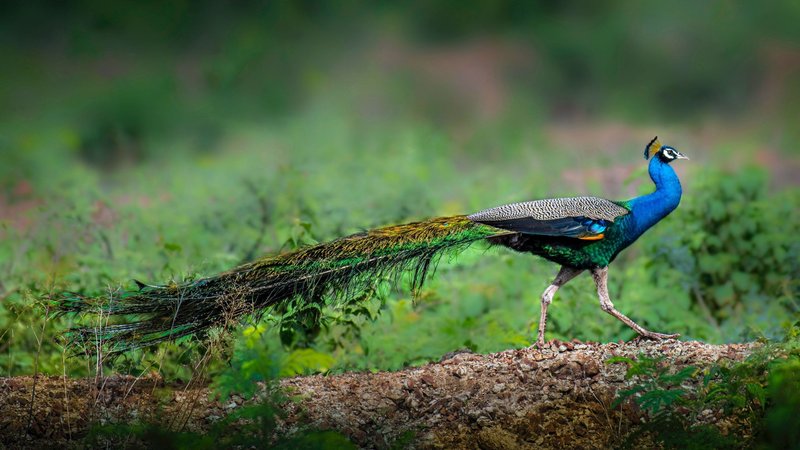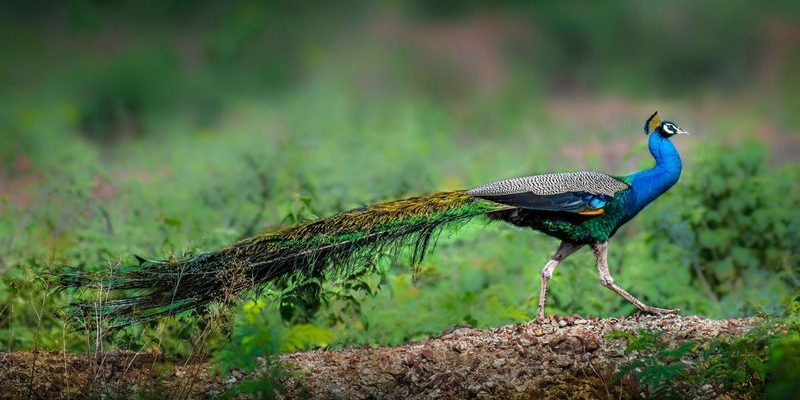
Now, you might think you know a thing or two about these birds. Maybe you’ve seen them at a zoo or in a nature documentary. But there’s so much more beneath the surface than just their gorgeous tails. Let’s dive into the top 10 interesting facts about the peacock that might just surprise you.
1. The Peacock’s Tail: A Display of Brilliance
When someone mentions a peacock, the first thing that often comes to mind is its spectacular tail, called a train. Honestly, it’s hard not to be mesmerized by those radiant colors and eye-like patterns. The train can be up to five feet long and is made up of ‘eyes’ that are actually small, circular spots.
You might be wondering why such an elaborate tail? Here’s the thing: it’s all about attracting mates. Males will fan out their trains to show off their beauty during courtship displays, hoping to woo a female. It’s a classic case of “look at me!” in the animal kingdom. Females, called peahens, often choose their mates based on the quality of the tail, which signals the male’s health and vitality.
2. Not Just a Pretty Face: Their Vocalizations
Peacocks are not just silent models; they have a rich repertoire of sounds. They can make loud calls that can be heard from quite a distance. For instance, their call can sound like a “meow” or even a “taaa” noise. It’s like they’re having their own concert in the wild!
These vocalizations aren’t just for show. They can communicate various messages, from warning others about predators to signaling their location. Next time you hear a peacock, think about what it might be saying to its feathered friends—or even to you!
3. They Can Fly (Sort Of)
You might be surprised to learn that peacocks are quite capable of flying, even though their tails look heavy. Adult males can soar up to 10 to 13 feet in the air! While they’re not exactly graceful fliers, they can manage short flights, mainly to escape predators or reach a safe roosting spot for the night.
Imagine a peacock taking off, its vivid colors trailing behind like a vivid rainbow in the sky. They’re more suited for short bursts rather than long flights, but when they do take off, it’s a sight to behold.
4. A Symbol of Beauty and Grace
In many cultures, peacocks symbolize beauty, pride, and even spirituality. In Hinduism, for example, the peacock is associated with the goddess Saraswati, representing wisdom and learning. This adds another layer to their already rich symbolism.
Their stunning appearance has made them popular in art, fashion, and even jewelry. Many people see them as a sign of elegance and grace. You might find peacock motifs in home decor, clothing, or even tattoos, showcasing how this bird has inspired creativity across the globe.
5. Diet Diversity: What Do Peacocks Eat?
Peacocks are omnivores, which means they eat a variety of foods. Their diet consists of seeds, fruits, insects, small mammals, and even snakes. Picture a peacock roaming through the woods, pecking at the ground, and discovering hidden treats.
What’s interesting is that their diet can vary based on their environment. In the wild, they’ll adapt to whatever is available. If they’re living in a more urban setting, they might even snag some scraps from gardens or parks. They’re pretty resourceful when it comes to finding their next meal!
6. Social Birds: A Community of Peafowl
Peacocks aren’t solitary creatures; they thrive in social settings. Typically, they form small groups or flocks, often consisting of several peahens and one or more males. This social behavior helps them protect one another from predators.
Their interactions can be surprisingly complex. They communicate through body language and vocalizations, strengthening bonds within their community. Watching a group of peacocks interact can be both entertaining and enlightening, as they display their personalities and quirks.
7. Lifespan and Maturity: A Long Journey
Peacocks have a relatively long lifespan for birds, often living up to 15-20 years in the wild. However, they typically reach full maturity around three years old. This can feel like a long wait, but these years are essential for developing their stunning feathers and personality.
During this time, young males undergo significant changes. Their tails grow longer and become more vibrant, making them more appealing to potential mates. It’s like a coming-of-age story in the bird world!
8. Their Colorful Feathers: Science Behind the Shine
The dazzling colors of peacock feathers aren’t just a product of pigments. Surprisingly, they get their vibrant hues through microscopic structures in the feathers that reflect light. This phenomenon is called structural coloration.
So when you see a peacock displaying its feathers, you’re not just witnessing a colorful display; you’re observing a marvel of nature! This unique way of producing color can appear differently based on the angle of light and perspective, making them ever so captivating.
9. Native Habitats: Where Do Peacocks Live?
Peacocks are native to South Asia, especially in countries like India and Sri Lanka. They thrive in forested areas, grasslands, and even some urban habitats. They prefer places with plenty of trees for roosting and open ground for foraging.
Unfortunately, their habitats are sometimes threatened by human activities, including deforestation and urban expansion. This makes it crucial to understand their role in the ecosystem and appreciate the beauty they bring to our world.
10. Cultural Significance: Legends and Lore
Throughout history, peacocks have been woven into myths and legends. In Greek mythology, the peacock is connected to Hera, the queen of the gods, symbolizing immortality and resurrection. Their beautiful feathers have also been said to represent the eyes of the universe, giving them a mystical association.
These cultural connections enhance how we view peacocks today—beyond just their striking appearance, they serve as a bridge between nature and human storytelling. They remind us of our fascination with beauty and how it extends beyond our everyday experiences.
In conclusion, peacocks are much more than stunning birds. They’re full of surprises, history, and significance. The next time you spot a peacock, take a moment to appreciate every aspect of its being—not just the feathered beauty but the intricate life it leads. You may find that these avian wonders are even more fascinating than you ever imagined!

